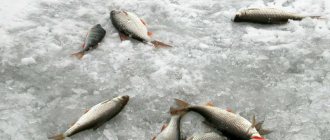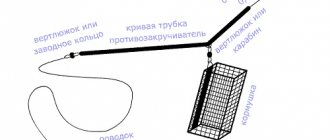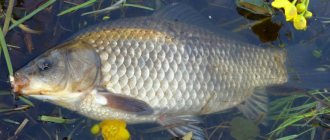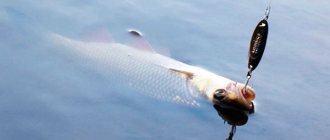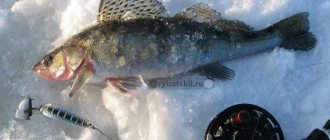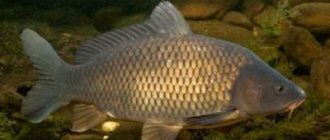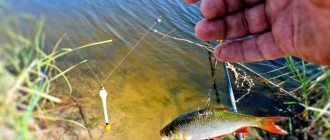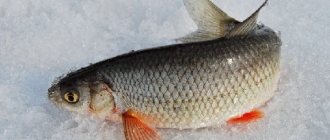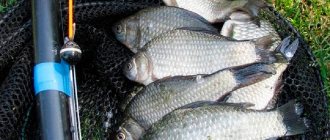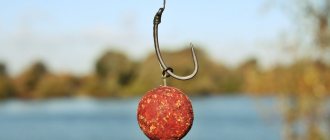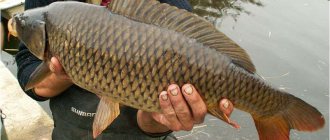How to fish on a ride
Our tackle is assembled and ready for use.
We lower it into the hole, turn off the stopper on the reel and wait for the sinker to reach the bottom. After that, you need to begin to smoothly swing the bait with the tip of the rod, while the nod should also be worked out by swaying smoothly. This is similar to winter jig fishing, but with less intense and more amplitude fluctuations of 3-15 centimeters. When you swing the rod, the weight moves at the bottom, raising “clouds” of turbidity that attract fish. The bait also oscillates in the water flow, arousing the interest of underwater inhabitants.
If there are no bites for the retrieve, then the tip of the rod is raised high and the load with the equipment is carried further by the current, after which it is smoothly lowered to the hole with rocking and a series of retrieves and taps on the bottom are repeated. Often bites occur when the tackle is gradually lowered. You can also release the bait further downstream by releasing the line using a reel, periodically making lifts with the rod, allowing the current to carry the load after the bait.
When the fish grabs the bait, it will be easy to understand by the movement of the nod or, if fishing is done without it, by the stretching of the fish. In any case, cutting is required. The hook must be wide because it is necessary to straighten the line to the sinker and leader. A long rod also helps here. The caught fish is caught by hand, choosing a fishing line, or using a reel.
It happens that after several successful bites, there may be a slight lull. No need to change location. You need to wait for the next school of whitefish if the fishing spot is baited, or lower the tackle downstream of the river by releasing an additional piece of fishing line from the reel and look for fish there.
Who gets caught riding?
There are no restrictions on the species diversity of fish for catching. Pokatok is a universal tackle. With some experience and skill, you can fish in this way both peaceful fish and predatory representatives of the underwater fauna.
Fishing for bream, silver bream, roach, chub and carp is especially effective. Of the predators, perch and pike perch are excellently caught in the potyag, which actively react to the dynamic movements along the bottom of bait of animal origin. A prerequisite is the installation of gear from elements corresponding to the size of the fish that is supposed to be caught.
Who is being hunted?
Grayling is considered a noble fish, it is caught wherever possible, but when planning to hunt for it, you need to prepare for making gear. What gear is needed is a separate question. You will have to learn what a catchable bait is, what a fly is and how it is made, learn how to tie intricate knots and much more. Unforgettable summer sunrises on the river are a special holiday for the soul. And it’s a completely inexplicable state when you return home with a good catch.
Everyone is familiar with the natural live fly. An artificial fly as bait is something else. Flies for catching grayling are a suitable option to naturally and quietly start the most persistent game with grayling. The grayling breed is closely related to whitefish and salmon. The grayish fish with spots and a powerful dorsal fin lives in cold water bodies. Habitat: rivers of Siberia, Europe, Mongolia. Siberia is a rich fishing region. The boundless Siberian space has many fans of fishing in the most secluded corners. It is characteristic that summer fishing here is inferior in attractiveness to winter fishing. Observant anglers have compiled characteristic descriptions of grayling.
They say about him:
- he is active, agile, senses danger better than other fish;
- a school form of living is good for young animals;
- adults start their own flocks;
- the best places for young animals are shallows;
- as they get older, they move to deep-sea pits;
- winter at depth;
- in the spring they rise up and form pairs.
Regarding the bite, the following picture has developed by season:
- Winter fishing is carried out with a fishing rod and bait; at the end of March you can expect the best results, and so on until the ice breaks up.
- With the onset of spring, another type of fishing is undertaken - reeling, plumb fishing, fly fishing, using worms and flies, and larvae for bait.
- Summer is the best time for picturesque fishing, when grayling hunts for insects (flies, dragonflies).
- At the end of summer and beginning of autumn, they prepare flies for grayling and worms; at the end of autumn, the bite decreases, and the fish go to winter.
Summer time passes quickly. If you knit your gear correctly, then on a summer day you can catch not only a fish product, but also a lot of joy.
You need to keep in mind that you cannot fish with the same bait all year round and in different bodies of water. It is difficult to predict in advance what the best bait will be suitable on this particular day and in this place.
Bottom control
The success of playing a jig in the current with conventional equipment is based on two pillars - correct installation and special play for these conditions. Standard saw, herringbone and dribbling do not work. You just need to not curse the flow in your head, but find a common language with it and use the physical properties of the flow.
The selection of the nod, the thickness of the fishing line and the weight of the jig is carried out so that the tackle is held at the bottom after lowering. At the same time, when lifting the gear, for example, 20 cm from the bottom, the working descent increased by 10 cm (50%). Accordingly, this distance will need to be lowered from the reel - this means that the jig has been pulled further under the ice by the current (but is not carried - the bait has stopped again). The difficulty is that such gear cannot be prepared at home in advance - all manipulations are carried out already on the reservoir, at a specific depth and strength of the current. You need to take a thin fishing line - it simply has less windage, therefore, such a monofilament is not strongly inflated by the current. Alternatively, instead of one heavy jig, you can use a steam locomotive of 2-3 smaller ones.
Traditional fishing on the rise is not used. In the current, we catch it on release, tugging the tackle in small steps. At the same time, the jig moves under the ice a little further each time. It is at this lowering after rising that 90% of bites occur. The drag limit is determined by the nod - you can let go as long as the bait is felt. Then, in the reverse order, we raise the fishing rod, but now we don’t lower it, but wait until the jig goes to the bottom against the current. Thus, you can’t work with high-frequency oscillations here - you get rises and falls of the jig, slowed down by the current. At the same time, even when stationary, the bloodworm on the hook moves, which additionally attracts fish.
Playing on a loop
In a strong stream, on which even a tungsten jig cannot hold, a heavy sinker is added to the rig at the end of the fishing line. A working jig (heavy fly) is tied 30-40 cm higher by a locomotive or on a lead leash. Soft nods are not suitable for such fishing, nor are too hard ones. The desired option can only be selected experimentally. The game is a careful pulling of a line loop inflated by the current without lifting the sinker from the bottom and releasing it back.
At the same time, the jig moves diagonally to the bottom (if it’s heavy, it can even reach it) and back. This method is used to catch roach and grayling in the current. However, it is still better to place the jig on a retractable leash. In this case, if there are no bites on the tension, we switch to catching without changing the equipment. At the same time, the sinker is still selected not too large, usually 10-20 grams. With enough lift, it should come off the bottom and be pulled under the ice.
Pull (let down)
Winter fishing with a jig on the current in the winter by pulling is carried out in the same way as rolling with bottom tackle. In essence, it’s the same thing, it’s just that on the leash it’s not a hook with bait, but a jig. The installation was not carried out inline (sliding), but on a branch lead. The sinker with the leash moves further with the current
In this case, it is important to catch the rhythm of the nod movement. A bite is often noted as a delay in the movement of the guard
The leash with the jig is freely stretched by the current and does not get tangled with the main fishing line. The main thing is to make the twitches smoothly and briefly, without sharp and long jerks. The farther from the hole, the more amplitude the swing of the hand is - after all, you also need to select a loop of fishing line from the stream. And so on to the limit - arms raised above the head at the top point of the swing at the farthest distance. Then - in reverse order. In this way, a large area of water is fished - up to 20 meters downstream.
The principle of stream fishing
This is interesting: Fishing for perch in August - how to fish with a spinning rod, a float rod, what bites better
Where to go fishing
Many experienced fishermen use rolling gear only for wintering pits (provided there is no ban on fishing), which collect all peaceful fish with the onset of the first serious frosts.
When deciding where exactly to drill a hole, it is important to take into account the presence of weather conditions, depth, strength of the current, as well as the distance of the place from the beginning of the dump. At the same time, it is important to understand that in winter the fish behave quite carefully, which means that in order to catch, for example, crucian carp, you may need to feed the bait directly to the nose of the fish itself.
For more information about the construction of the fishing gear and fishing for the fishing, see the video below:
[custom_ads_shortcode2]
Rigging tricks
As noted earlier, the option for setting up a winter skating rink is very simple and familiar to winter fishing enthusiasts.
How to properly tie a jig to a fishing line Winter fishing for gudgeon with a jig How to catch taimen in winter Winter ice pick: purpose, types, making the tool yourself
A regular fishing rod is used, equipped with a small inertial reel, a main fishing line with a cross-sectional size of 0.15-0.18 mm, a swivel, and a hook with a leash.
Usually the conditions in which fishing takes place make their own adjustments. So, when choosing a fishing line, it is worth considering that its thickness largely depends on the activity of the fish. You can read the material on how to choose the right winter fishing line.
For example, in the dead of winter, when there is practically no bite, it is possible to use very thin fishing line with a cross-section of up to 0.1 mm and small hooks.
For catching medium-sized fish, hooks No. 14 are suitable; if you expect larger sizes and active behavior of the fish, then you should stock up on hooks No. 12.
The length of the leash (40-100cm) depends directly on the size of the load: the larger and heavier it is, the longer the leash should be
Moreover, for winter fishing by rolling it is very important to choose a sinker with an optimal weight so that it does not lie as a heavy and heavy load on the bottom, but at the same time not to allow it to be easily carried away by the current
For reliability and durability of the tackle, it is better to use tungsten leashes.
An important part of this tackle is the nod. When fishing by rolling, it not only determines the bottom, but it also allows you to track the bite and timely determine the moment of hooking
A correctly made nod should be very sensitive and respond to the slightest touch of the fish. Often the nod for rolling fishing is made of a metal spring with a diameter of 5 mm; a clock spring is good for this.
What to catch while skating
This technique is especially effective when it comes to catching all kinds of river whitefish, namely bream, white-eye, crucian carp, etc.
As for bycatch, you can often catch perch and even pike perch this way. In most cases, the rolling method itself involves fishing without active movement along the holes, and to achieve a positive result from this method of fishing, it is best to come fishing only to those places where the bottom topography, the strength of the current and its nature are precisely known.
[custom_ads_shortcode1]
How to tie fishing knots
Some of you may have noticed that in the catalogs of various fishing companies and on the boxes of some products (hooks, cords or fishing lines) instructions on how to knit fishing knots are often indicated. These units are suitable for gear in the category or on the box of which this diagram is depicted. They are constantly updated and have a very large margin of safety.
But no matter how strong the knot is, in any case it negatively affects the strength of the fishing line, some deteriorate it almost twice. And this, in the worst case, can lead to a breakage of the gear at the most crucial moment.
You can’t do without knots, because absolutely all gear must be connected to hooks, leashes or lures. Every beginner and experienced angler must know how to tie the right fishing knots; for this, several tricks are used that will help you quickly and without much difficulty tie a strong and reliable knot.
Recommendations from experienced anglers:
- Before tying a knot on a monofilament, experienced fishermen advise holding it in the sun so that the material becomes softer.
- If it is a braided cord, then it is recommended to moisten the structure with water before final tightening the knot. This will help reduce friction and increase the strength of the knot.
- To tie a hook, you should choose one of the simplest options. The simpler the knot, the less deformation the line undergoes. In this case, reliability directly depends on the number of kinks.
- Do not expose the fishing line to external fire under any circumstances. It is better to cut off the excess with scissors.
The knitting pattern for the ideal fishing knot has been found by fishermen for a very long time. This is facilitated by the considerable experience of our predecessors in combination with modern materials and technologies, which makes it possible to make very high-quality components
So, with the fact that the knot must be reliable and durable, we have figured out that another important requirement is simplicity. The knot should be very easy to tie
We recommend that especially lazy people watch a video that contains 5 simple fishing knots for all occasions. Well, for those who are interested in fishing knots for hooks, we recommend reading further and looking at the photos that show step-by-step diagrams of these knots.
Video: 5 fishing knots for all occasions
Stream fishing technique
Anglers use two main techniques when using a skate rig.
Dynamic fishing is considered a classic of the genre. It is used most often when catching white fish in pits. First of all, it is necessary to determine the bottom topography and current speed.
It is important to make a hole at the beginning of the fall, so that when the equipment is released, the bait realistically rolls into the depths. After lowering the bait into the hole, you should wait until the sinker sinks to the bottom
Having loosened the reel brake, the equipment is released 0.5-1.0 m downstream. After this, the sinker stops and a short wave of the hand is performed. At the first stage, the movement should be smooth, in the last 0.5 m the swing becomes sharp. This is explained by the fact that at the time of pulling, the fish most often bites. If the bite does not occur, then the sinker is given the opportunity to roll further another 1 m. The cycle can be repeated 10-12 times. Experienced fishermen fish the bait from the hole at a distance of 20 m.
Advice! If bites occur at any segment, then it is necessary to stop rolling the sinker. This distance should be recorded, and the next wiring should be completed at this point.
An important point for a novice fisherman in winter fishing is the feeling of the bottom. The hand must clearly determine the position of the sinker, and the fishing line is always tensioned when retrieving. If there are no bites after 2-4 full rolling cycles, it is better to look for a new place.
When using rolling gear, you can use bait. This is done when the fish does not let itself know. Holes are made along the line of movement of the equipment with a discreteness of 2 m. Food consisting of bloodworms and soil is dropped into each of them. If a predator is caught, dried blood is injected instead of bloodworms.
- Passive technology is much more primitive and simpler. The rig with bait is lowered to a promising place, after which the fishing rod is fixed at an angle of 30-60 degrees to the ice surface. The fisherman just has to keep an eye on the fishing rod, having previously fed the holes with bloodworms or breadcrumbs mixed with soil.
Features of ice fishing
The equipment is immersed in the hole and the bottom is felt. The round weight is carried away by the current and rolls over. Turbidity forms in the water, which serves as bait. How fishing is done depends on the time of year.
in winter
In winter, fishing is done from a standing position. The fisherman needs to have knowledge of the terrain and the strength of the current in the fishing area. They try to drill a hole upstream, 2 m from the start of the dump.
The sinker must be sent to the bottom and released further downstream. The tackle must be stopped and pulled in your direction. Bites occur after the described manipulation.
If the bite does not occur, the tackle should be released further downstream at the same distance. The procedure is repeated again until the fishing line has stretched sufficiently.
Bites are also likely during the process of returning the fishing line. If you reel 2 m at a time, you have a chance to catch a perch. After 5 leashes, the fisherman should move to another location.
Winter fishing requires compliance with a number of conditions. It must be remembered that at cold temperatures, composite and carbon fiber types of whips can easily break. Therefore, before fishing, the products need to be cooled: kept in the open air. The tackle must be held in such a way that it is constantly at the bottom.
If the bite occurs far from the hole made, the fisherman should move away to a distance in order to collect the fishing line more evenly. The remainder is selected manually. Otherwise, the wind will twist the line, creating a lump that cannot be untwisted in cold weather. In strong winds it is worth taking a reel.
In summer
It is important to prepare: study the terrain, check the fish sites. This may take 2-3 days.
It is most effective to fish from a boat that is not moving through the water. For these purposes, the anchor is dropped directly at the place where fishing will take place. The result depends on the stability of the boat.
For bait, baits are made from shelled peas. Therefore, they feed the prey with the same product. Peas need to be soaked and boiled. The food should be boiled, but not fall apart, otherwise it will be inconvenient to use.
They start with bait for fishing. 10 peas are collected on a needle. The bait is sent down, after which you can start hooking the prey. This should be done actively.
Choose a pea that will act as bait. Large, slightly cracked specimens are attractive for prey.
Fishing principle
In winter, fishing on a frozen river has a number of features. This includes the current, which carries the equipment away from the baited point under the hole, and heterogeneous ice at the beginning and end of winter, and cautious fish that are afraid of the sound of an ice pick or ice drill. All these problems can be solved with the help of winter skating gear.
It is not possible to buy ready-made tackle in all fishing stores, so novice fishermen will have to practice making it, relying on the advice of experienced comrades. The fishing rod consists of a rod with a reel and nod, a supply of monofilament of 20-30 m, a sinker and a leash with a hook. The principle of fishing is to periodically release the equipment downstream. The bait rolls along the bottom, which is why the fishing method received the corresponding name. In some regions, a similar option for catching fish is called pull fishing. There are two types: static and dynamic.
- With a static (passive) approach, the fishing rod is placed motionless near the hole, only occasionally a pull is made. The use of such a scheme is justified when a certain area under the hole is baited and the fish is in close proximity to the angler.
- Dynamic (active) fishing involves constant use of gear. The bait is then released, then pulled up, sending the equipment at a distance of 10-15 m from the hole. This type of fishing is considered search fishing. With its help, you can find feeding fish over a significant section of the river.
What kind of fish can you catch using a rolling tackle?
Winter fishing video
Stream fishing in summer
Nowadays, ice fishing has significantly decreased in popularity. But before, they used it to readily catch bream, roach, and ide. This type of fishing is truly exciting and effective.
Features of gear
Summer gear consists of:
- A compact and sensitive rod, the length of which does not exceed 1.5 m.
- An ordinary inertial coil.
A fishing line, the diameter of which is 0.2-0.25 millimeters, is threaded through the rings. Next, the cambric and sinker are attached. A ring is tied to the end of the scaffolding, and a leash and hooks are attached to it. Moreover, its length does not exceed 45 centimeters.
to the winding ring. It is made according to the following principle: a 15-centimeter piece is cut off from the steel wire. Then one end of this segment is sharpened. On the opposite side, a lock is formed to connect the ring and the needle.
Using the skating rink in summer
Roll fishing is carried out mainly on the river, because this species requires the presence of currents. In the summer, you should fish not from the shore, but from a boat. Preparation for fishing is a responsible event that affects the future catch. It is important to study the topography of the reservoir and identify possible fish sites. It will be great if the fisherman devotes at least two days to this stage.
Roll fishing involves stopping the boat in one place. The anchor is released directly above the pit. You should position your watercraft as stable as possible.
The fishing process begins with luring fish with a bait mixture. To do this, ten peas must be strung on a needle, and then lower the rod to the bottom. When the tackle reaches the bottom surface, you need to make a quick hook, then the peas will fall off the needle and be carried away by the current. It is recommended to do this a couple of times. Then you need to select a pea for bait. Fish prefer large and slightly cracked specimens.
Fishing technique for skating in summer
From the beginning, the angler lowers the rod to the bottom. The fishing line should be like a string - tight and stretched. The role of the sinker in this case is to hold the tackle in one place. If several minutes are unsuccessful, you should lower the line a little, and the current will pull it out in an arc. Then you need to raise the rod for a while and then lower it again. This is done to lower the gear downstream.
If after this the bite does not occur, the procedure is repeated again. When the tackle is no longer carried away by the current, it is worth pulling it out to start fishing again. The bait is torn off the hook by means of a sharp hook. If even the sixth transaction did not bring any results, you should not despair. Each pea left in the water increases the chances of a successful bite.
Fishing on the rink is accompanied by barely noticeable bites. Therefore, when choosing a fishing rod, it is important to be guided by its sensitivity. Lightning-fast and timely hooking is a prerequisite for successful fishing.
By the time the prey begins to swallow the pea, the end of the tackle will barely tilt toward the water surface. At a time when the fish has not yet managed to get off the hook, a quick hook is carried out. If the desired prey managed to escape, then the bait is picked using the already proven method in order to repeat the familiar procedure.
There is no doubt that downstream fishing has lost its former relevance for the reason that the resulting reservoirs reduce the number of fishing spots on the river with a current that are convenient for this type of fishing. But when there is a suitable river nearby, then this wonderful method definitely needs to be tried.
Read further:
DIY fishing boat
Catching fish with eggs in summer from a boat
Catching pike perch with live bait from the shore
Technique
The technique of downstream fishing is also very simple; it can be easily mastered by a beginner in just a few minutes. First, the tackle is unwound, bait is put on the hook, and for greater attractiveness, a foam ball is sometimes placed on the hook. You can get foam balls, you can buy them - they are sold separately, there are already flavored ones. Everything is put on, the fishing rod is taken, the reel stop is turned off, and the equipment is immersed in the hole.
IMPORTANT! If you have a “bomb” (it’s on a fishing line), then we drown the bait before the equipment is immersed, otherwise it will get mixed up, if it’s a ball - at any time. The fisherman waits for the sinker to reach the bottom and begins to move up and down
Like a jig, only smoothly and with a little more amplitude, about 3-15 centimeters. The sinker will remain lying, and the line will slide, the bait will move down the river under the influence of the current. You can let it go even further, in case you run into a fish trail, which will be just below your hole
The fisherman waits until the sinker reaches the bottom and begins to perform an “up and down” movement. Like a jig, only smoothly and with a little more amplitude, about 3-15 centimeters. The sinker will remain lying, and the line will slide, the bait will move down the river under the influence of the current. You can let it go even further, suddenly you will run into a fish trail, which will be just below your hole.
And with such smooth movements we sit and attract fish, waiting for a bite. Sometimes you will have to literally move your hand with the fishing rod behind you in order to pull the sinker towards you (it will hit the stopper) if it gets carried away by the current. If he bites, you will feel it, otherwise the nod will show. We hook sharply, then it’s your choice: put the rod down and pull with your hands or reel with a reel.
Instead of a conclusion, we will give a few secrets from experienced fishermen:
- It’s better to take a sinker with a polyvinyl chloride tube - this way the line will fray less,
- imagine the movements we just described. It is easy to identify another fisherman using them. If he does this with his hand, most likely he is fishing for a ride. Whether he bites or not is another question,
- a hole drilled at an angle towards the current will make fishing easier,
- the thicker the line, the higher its windage - the current will oscillate the bait better,
- It’s better to take a wide ice screw, who knows, maybe a wide bream might bite,
- In winter there is no hunger, the fish become even more suspicious. It would not hurt to choose a colored fishing line according to the color of the bottom and water.
Favorable conditions for skating fishing
To successfully go fishing, you need to do some preparation. In particular, you should scan the bottom well to identify possible sites for ide, bream and roach
It is very important to detect edges or slopes, or, in extreme cases, anomalies on the bottom or a shell. Experienced miners are engaged in attaching fish
Naturally, these are those fishermen who live next to the reservoir and are not burdened with unnecessary worries. Within 2-3 days, they regularly throw simple bait onto a promising area. It could be bran with some boiled cereal. On the day of fishing, they feed the fish with a more appetizing mixture and collect decent yields of measured fish.
Most often, when fishing for fishing, whole peas are used. For this reason, peas are often added to the bait.
Since you will have to fish in the current, it is important to prepare soft enough peas for the bait so that they stick well to the hook, but at the same time do not get carried away by the current
Summer fishing
When fishing from a boat, you need to anchor in front of the hole. Make sure that the anchors pull the ropes well and the boat takes a stable position. This must be achieved first of all, since we are talking about fishing on the current.
Having installed the boat, we perform the starting feeding. We use river bait. If the current is strong, add soil or clay to it and be sure to place peas. After feeding, we throw out the tackle. The line should be as taut as a string. We wait 3-4 minutes. If there are no bites during this time, then release the line from the bow to form a small arc. We wait a few more minutes and make a small reel, after which we lower the tackle to the bottom. The result is a situation where the weight with the nozzle constantly moves with the flow. The tackle remains stationary for several minutes. After that, she is released with the flow. It can roll up to a certain point until the weight stops. As soon as this happens, you need to unwind the tackle and attach a new pea.
We make 6-8 similar postings. If during this time there are no bites, then you can change the tactics slightly, or just wait for the bites. It is quite possible that the fish will come up later. For example, ide does just that. He may not bite for a long time, but then within a few hours he will catch up.
Experienced bottom fishers, who have been fishing from boats for years, are already well aware of such features of fish. They go fishing at certain hours and fish until a certain time.
An effective method is to make a path out of bait. To do this, you can attach a large feeder on a carabiner to a swivel and stuff peas into it. You should throw the feeder at different distances along the length of the broach. After casting, you can wait a little and make a sharp jerk with the rod. This way the contents will be released easily.
It’s interesting that fish bite in a special way when fishing on a roller. Since we use a sliding sinker, all the slightest bites are visible if we use a sufficiently sensitive fishing rod. Although, to tell the truth, when fishing in the current, the fish bite quite clearly. It is very difficult not to notice the sharp twitching of the rod tip.
A sliding sinker offers good benefits. You can use heavy balls, but the tackle will remain sensitive. The same bream will not feel heavy during bites and will not spit out the bait, as sometimes happens when fishing with a rigidly attached sinker.
It is important to ensure that the fishing line is taut. Otherwise, you may miss the bite, and further hooking will not make the slightest sense. It sometimes happens that the top slowly bends. This means that an ide or bream is trying the bait. At this moment you should make a hook. If you fish with peas, you need to hook them in time. The ide often bites with short pokes. If you miss this moment, you can’t count on subsequent bites. It is better to reel out the tackle and re-bait the bait.
It cannot be said that the ride is suitable for all rivers. This is a specific tackle. There is no point in fishing with it in areas without a current. In any case, it can be done within 5 minutes. Just keep this option of bottom equipment in mind so that, under certain conditions, when fishing from a boat, use it for its intended purpose.
How to collect gear?
Fishermen have come up with several schemes for equipping the skating rink. Depending on the conditions and type of fish, the most suitable modification is collected. You can prepare the tackle yourself.
- For active fishing, a rod 0.6-1.0 m long is required. It can be made of plastic, wood or bamboo. An inertial reel with a line supply of 0.25 mm up to 30 m is installed on it. A spherical sliding sinker is mounted on the base and fixed with a silicone stopper.
Recommendation! It is often possible to select the correct sinker weight only on the river. Therefore, you need to have a set of weights with different weights with you.
A leash 0.5-1.0 m long made of 0.14-0.16 mm monofilament is attached to the end of the main line. The hook is selected according to the size of the fish and bait.
Since during active fishing the fishing rod is constantly in the fisherman’s hand, it is not necessary to set up a guard. The bite is clearly transmitted to the hand.
- How to make a slide for fishing in a static position? A distinctive feature of gear for passive fishing is the presence of a nod. When the tackle is installed above the hole, the angler will monitor the bite with a guard. You can fish with 3-5 fishing rods at the same time.
Photo 3. Fishing rod for skating.
It is important! With the static fishing method, large fish can drag the fishing rod into the water. You can prevent loss by securely securing the tackle on the ice or protecting the hole with some kind of cover. The rod is selected 40-60 cm long with an inertial reel and nod
The supply of fishing line on the drum is 15-20 m. A sliding or stationary spherical sinker is mounted on the base. A piece of fishing line 10 cm long is tied above the main load. The junction with the main thread is fixed with three lead pellets. They should be located as close to the base as possible. This is done to prevent the sinker from slipping into the loop. The number of pellets ranges from 2 to 5 pieces, which depends on the strength of the current. A double swivel is tied to the end of the main line. The leashes are equipped with small pellets, their weight should hold the hook with bait at the bottom
The rod is selected with a length of 40-60 cm with an inertial reel and a nod. The supply of fishing line on the drum is 15-20 m. A sliding or stationary spherical sinker is mounted on the base. A piece of fishing line 10 cm long is tied above the main load. The junction with the main thread is fixed with three lead pellets. They should be located as close to the base as possible. This is done to prevent the sinker from slipping into the loop. The number of pellets ranges from 2 to 5 pieces, which depends on the strength of the current. A double swivel is tied to the end of the main line. The leashes are equipped with small pellets; their weight should hold the hook with the bait at the bottom.
Photo 4. Equipment diagram.
How to fish with a small pull
While on the ice, release the brake on the reel and launch the equipment into the hole. The fishing line is pulled off with your fingers, since the reel drum is located in the housing, and this causes additional unwanted friction, and besides, the fishing line is passed through the nod, which also prevents it from moving freely.
It is very important not to miss the moment when the sinker hits the bottom (determined by the slack of the fishing line). The weight of the sinker is selected in accordance with the speed of the current in the section of the river chosen for fishing.
Having beaten the bottom, they launch 1-1.5 m of fishing line, and when it becomes taut, adjust the nod. Then, slowly and smoothly, they begin to play with a fishing rod, as when fishing with a traditional jig tackle, with upward lifts. Bringing the fishing rod to chest level, make smooth upward strokes. If there are no bites, they are released 50-60 cm and the equipment is launched again.
It has been noticed that if the fish bites well in the morning, then it is almost guaranteed that there will be a bite in the late afternoon. So it won’t be superfluous to check catchy morning holes several times during the fishing day.
What components are needed to assemble the roller?
To assemble the ride you will need:
- Rod;
- Coil (spinless or wire);
- Line (main and leader);
- Sinker (olive or ball);
- Swivel;
- Stop bead;
- Hook.
For downstream fishing, choose a durable fishing rod from 50 to 120 centimeters long with a large diameter reel. The main requirements for a fishing rod are sufficient rigidity and length. Some people make a fishing rod using a broken spinning rod, while others look for a suitable one in the store.
A long fishing rod is necessary for comfortable control of the tackle, since the load is gradually carried away by the current and needs to be pulled back or released further with fairly wide movements. In general, long upward pulls and then a smooth lowering of the rod towards the hole are one of the elements of fishing with this tackle.
A large diameter reel is needed to speed up work with tackle and mobility when moving. Due to the fact that fishing is carried out in currents and depths, sometimes in order to get to the fish you have to let a very long piece of fishing line go under the water.
The main line with a diameter of approximately 0.2-0.3 mm is wound onto the reel. When choosing the diameter of the fishing line, you need to understand that with greater depth and/or strength of the current, a thicker fishing line will “sail” more, so a heavier load will be required, which can make the tackle cumbersome.
A lead or tungsten weight with a hole is placed on the fishing line. The shape of the load is olive or ball.
The weight of the sinker must correspond to the diameter of the main line, the depth and current in the river. Typically this is 3 to 6 grams, but weights up to 20 grams can be used.
Weights with a PVC tube inside work well, because they do not fray the fishing line and glide along it perfectly.
The sinker must slide freely along the main line to provide the angler with the opportunity to play with the bait.
Then, behind the load, a plastic bumper ball (stop bead) is placed on the main line so that the load does not hit the swivel.
Next, the swivel is tied. A leash made of thinner and preferably high-quality fishing line is tied to it. The last element is the hook that we will tie to the leash.
You can purchase any swivels and locking beads, the main thing is not to use outright Chinese “cheap” ones, since due to a low-quality swivel, if it breaks, you may lose the long-awaited trophy.
The leashes use a thinner line, the diameter of which is selected based on the expected size of the local fish. As a rule, this is a fishing line with a diameter of 0.12-0.15 mm.
The length of the leash depends on the weight of the load used and the object being fished. When choosing a light one, you can set a leash of about 40 centimeters, and with a heavy load and when fishing in the water column, the leash is set from 40 centimeters to 1 meter.
If the bite is weak and capricious, or if there are no large fish in the reservoir, it is necessary to use a thinner line for the leash, which can have a positive effect on the number of fish caught.
Since the leash uses a thinner line, it is better to purchase high-quality products from well-known manufacturers Marvel, Owner for these purposes.
The hook is selected based on the size of the expected catch. For medium-sized roach we take No. 14, for large specimens and bream we use No. 12.
Often unfavorable conditions will also dictate the angler's hook size, for example when fish activity is low, a smaller hook size is recommended. It is also recommended to reduce the hook size when the bite is capricious, when there are many empty bites.
The fisherman always needs to have with him several weights of different weights, swivels, hooks, different sizes and a supply of leading line. Since there may be breaks in the gear or the need to change it to suit specific fishing conditions.
The nod when fishing on a roll gives the angler the opportunity to determine the moment when the load sinks to the bottom of the reservoir, as well as track bites in order to determine in time when to hook.
The nod should be sensitive and respond instantly to the slightest touch of bream and roach to the bait.
Anglers often use spring nods or silicone tubes for downstream fishing. Some people don’t use a nod at all, focusing on the sensitive tip of the rod as when fishing with a feeder and tactile sensations. Understanding whether a nod is required comes with fishing experience.
Stream fishing in winter
They are successfully caught on streams and in winter from holes. The tackle is the simplest. You will need a regular fishing rod with a nod and an inertial reel on which a fishing line with a cross-section of 0.18-0.2 mm is wound. The leash is used with a thickness of 0.1-0.14 mm. Here they are already looking at the activity of fish. If the bite is good, for example, roach, then you can tie a thicker leash. The length of the leash varies from 40 to 100 cm. It depends on the weight of the load. The heavier the sinker, the longer the leader used.
Hooks are used mainly for bloodworms. Their sizes range from 16 to 20 according to international numbering and are always made of thin wire.
Perhaps the main element of the winter skating version is the nod. With its help, not only bites are tracked, but also the topography and structure of the bottom are determined. The main thing is that the fisherman distinguishes when a bite occurs and when the load slides along the bottom.
Experienced fishermen most often use nods made from clock springs 4-6 mm thick.
The length of the nod is 20-25 cm. It is attached to the rod as follows:
When fishing from a hole, it is very important to choose the right sinker. We need to ensure that the tackle is not carried away by the current in the very first seconds after casting. On the other hand, this option is not allowed when the sinker is fixed at one point on the bottom.
The principle of operation of the roller when fishing in winter is approximately the same as in summer. An area with a current is selected so that the tackle moves periodically. Fish bites are recorded using a nod. If it is sensitive enough, then you can easily distinguish between its fluctuations during bites and when the weight moves under the influence of the current.
After the sinker falls to the bottom, a slow rise is performed with the nod swaying. It turns out something similar to when fishing with jigs, only the nod oscillations are more frequent. When bites occur, they are clearly visible by the nod. The line must be taut for the hooks to be effective. This is quite active fishing that will not allow the angler to freeze. Recasts need to be done quite often, so there is not much time for other activities.
When there is no bite, the tackle is reeled out and a new cast is made. To find the bottom, you have to release the line from the spool to move freely. As soon as the weight touches the bottom, you need to monitor the tension of the fishing line. You should not let her go a long distance. In this case, the windage will become critical and even a heavy weight will not save the situation. It is advisable to make marks on the fishing line with a marker (if possible) in order to determine the optimal release length of the fishing line. If we see that the line limit has been exceeded, then we reel it in to the required parameters.
If the fish bites immediately after touching, then we remember the point of impact and the amount of fishing line reeled out. On the next cast we repeat all the steps. When the bite is sluggish, lowering the fishing line with holds helps a lot. That is, the line has gone down a few turns of the reel, we pause for 2-3 seconds, then release it again. After completing 5-6 similar holds, you can count on catching a perch or roach.
In some cases it is necessary to increase the windage of the equipment. Most often, this method is used in cases where a larger fish has approached the point - ide bream and small roach. They put a lighter weight so that it is carried 5-6 meters by the current. If no one is fishing nearby, then you can fish. This method can sometimes bring very good, sometimes unexpected results.
